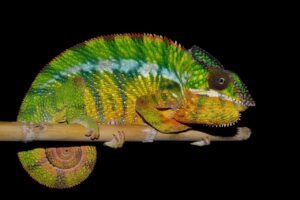Chameleons often display odd behavior when shedding, such as rubbing against objects and appearing lethargic. Their odd behavior is typically due to the discomfort associated with the shedding process.
Shedding, a natural and essential part of a chameleon’s life cycle, involves the periodic removal of their old skin to allow for growth and to rid the body of parasites. During this period, chameleons might act unusually and seem distressed.
Recognizing these behaviors is crucial for chameleon owners to provide the proper care and environment to ease the stress of their pet reptiles. By ensuring a habitat with appropriate humidity and foliage for rubbing, pet owners can help alleviate the discomfort chameleons may experience during this transitional phase. Understanding and responding to a chameleon’s shedding behavior can contribute to their overall health and well-being.
The Shedding Process In Chameleons
The Shedding Process in Chameleons is a fascinating and important phase in their life cycle. These remarkable reptiles regularly shed their skin to allow for growth, improve health, and remove parasites. Understanding the shedding cycle is crucial for chameleon owners to ensure their pet’s well-being.
Physical Changes During Shedding
As chameleons gear up for shedding, their skin changes texture and color.
- Skin appears duller and may develop a whitish hue.
- Reduced appetite and activity levels are common.
- They may seem irritable when handled due to discomfort.
Typical Shedding Cycles In Chameleons
The frequency of shedding depends on the age and species of the chameleon.
| Chameleon Age | Shedding Frequency |
|---|---|
| Babies and Juveniles | Every 3-4 weeks |
| Adults | Every 1-2 months |
Keep in mind, these cycles are general guidelines and individual chameleons may differ.
Weird Behaviors Observed
Chameleons are fascinating creatures, known for their vivid colors and ability to blend into their environment. Yet, during the shedding process, these calm creatures often exhibit a range of weird behaviors that can puzzle even the most devoted reptile enthusiasts. From restlessness to changes in their daily routine, it’s important for owners to understand these behaviors to provide the best care.
Restlessness And Irritability
As chameleons enter the shedding phase, their skin tightens, often causing discomfort and irritability. This discomfort leads to restlessness as they try to relieve the tension in their skin.
- Scratching against objects
- Attempting to rub off old skin
- Rapid changes in location
Changes In Eating And Drinking Habits
Noticing your chameleon skipping meals or drinking less water? This is common during shedding. Their body is focusing on the shedding process, which can reduce their appetite.
| Normal Habit | During Shedding |
|---|---|
| Consistent eating | Less frequent |
| Regular drinking | Decreased intake |
Increased Hiding And Avoidance
Chameleons often seek solitude when shedding. They might avoid interaction and hide more frequently to cope with the stress of shedding.
Common hiding spots:
- Foliage within the habitat
- Secluded branches
- Shaded areas
Understanding The Causes Of Strange Behaviors
Chameleons are known for their impressive ability to change colors and blend into their environment. Yet, during the shedding phase, these magnificent creatures often exhibit unusual actions. It’s crucial for pet owners and reptile enthusiasts to comprehend the roots of these odd behaviors. Such understanding helps ensure chameleons receive the care they need to navigate this challenging period comfortably. Let’s delve into the reasons behind their strange shedding antics.
The Discomfort Of Shedding Skin
Shedding skin is not a walk in the park for chameleons. This natural process, called ecdysis, can cause significant discomfort. As their old skin detaches, chameleons might scratch against objects, become more irritable, or refuse food. Their behavior can be alarming but knowing it’s a temporary phase is reassuring. Appropriate humidity and habitat conditions can ease their discomfort.
Vulnerability To Predators
During the shedding process, chameleons may feel exposed and vulnerable. Their defensive instincts heighten as they perceive an increased risk from predators. Owners might notice more hiding and less movement. It’s crucial to provide a safe and secure environment to help mitigate their stress. An understanding of this natural inclination for safety allows owners to better cater to their chameleon’s needs.
Internal Biological Adjustments
Apart from external factors, shedding initiates internal biological changes as well. Hormonal fluctuations and physiological adjustments take place, causing chameleons to act out of character. They might display lower energy levels or alter their eating patterns. Recognizing these signs as part of the shedding process can prevent unnecessary concern.
| Behavior | Possible Reason | Owner’s Action |
|---|---|---|
| Irritability | Skin discomfort | Improve habitat humidity |
| Less movement | Predator vulnerability | Provide hiding spots |
| Eating less | Biological adjustments | Monitor but do not worry |
How To Care For Chameleons During Shedding
Chameleons are fascinating creatures known for their color-changing abilities. But when it comes to shedding, they might exhibit some odd behaviors. They may act irritable or strangely as they shed their skin, which is a natural and essential process for their growth and health. As a chameleon owner, understanding how to care for your chameleon during shedding is crucial for their wellbeing.
Optimal Habitat Conditions
Creating a comfortable environment is vital for a smooth shedding process. Elevate humidity levels in the enclosure, as this helps soften their old skin. Ensure the habitat’s temperature is consistent, and provide adequate vegetation and climbing branches for skin removal assistance. The lighting should mimic natural sunlight cycles to promote regular shedding cycles.
Dietary Considerations
During the shedding period, your chameleon’s appetite may change. Offer food rich in vitamins and minerals to aid the process. You might want to include:
- Calcium-dusted insects to bolster skin health.
- Hydration through misting, giving them water droplets to lick.
- Additional supplements might be necessary as advised by a vet.
Keep a close eye on their feeding preferences and adapt as needed.
Minimizing Stress Factors
Shedding can be a stressful time for chameleons. Minimize disturbances by reducing handling during this period. Keep their living space calm and quiet. Infrequent interactions are best to assist a stress-free shedding. Monitor your chameleon but give it space and peace to complete its natural process safely.
Interpreting Shedding Signs
As a chameleon guardian, observing your pet’s shedding process is fascinating. In the wild, shedding allows chameleons to grow. It reveals vibrant new scales beneath the old. But shedding can seem strange. Do chameleons act weirdly during this time? Yes! Let’s decode these quirky behaviors and uncover what’s normal and what’s cause for concern.
Identifying Normal Vs. Problematic Shedding
Chameleons exhibit several signs that indicate healthy shedding. Some quirky behaviors are perfectly normal:
- Restlessness: They may seem more active.
- Appetite changes: They might eat less.
- Color changes: Their colors may dull before shedding.
- Peeling skin: Skin will lift, starting typically around the mouth.
Witnessing these behaviors signals a routine shedding cycle. Nonetheless, certain symptoms can suggest complications:
- Persistent old skin: Skin that doesn’t shed may indicate low humidity.
- Skin irritation: Constant scratching or biting may show discomfort.
- Wounds: Injuries from incomplete sheds need attention.
When To Seek Veterinary Care
While abnormal behaviors may arise, understanding when to seek help is crucial. Contact a vet if you notice:
- Infections: Signs of infection around the old skin are serious.
- Loss of digits: Fingers or toes at risk signify emergency.
- Behavioral extremes: Excessive lethargy or agitation is a red flag.
Routine checks keep your chameleon healthy. A vet can better diagnose issues. Early intervention can prevent severe health problems.
Mysteries Unveiled
Shedding or molting is a natural process for chameleons. This regular renewal of their skin can bring about peculiar behaviors. Some chameleons become more reclusive, while others might appear agitated or itchy. Understanding the intricacies of this process demystifies their unique behavior during these times.
Comparing Chameleon Shedding To Other Reptiles
Like snakes and lizards, chameleons shed their skin. Yet, their shedding process has its own special characteristics:
- Frequency differs with age – younger chameleons shed more often.
- Partial shedding – unlike some reptiles, chameleons shed in patches.
- Behavior during shedding can include rubbing against objects.
- They typically do not need assistance unless the environment is incorrect.
Fascinating Facts About Chameleon Skin
Chameleon skin is truly extraordinary. Here’s why:
| Skin Fact | Details |
|---|---|
| Color Change | The skin changes color for communication and temperature regulation. |
| Skin Layers | Multiple layers control light and heat, affecting the skin’s color. |
| Shedding Purpose | Allows growth, and removes parasites and old, damaged skin. |
Why their skin is special is no longer a secret. Unique abilities make shedding a critical time for these fascinating creatures.
Frequently Asked Questions For Do Chameleons Act Weird When Shedding?
How Do Chameleons Act When Shedding?
Chameleons become more reclusive and may exhibit reduced appetite while shedding. Their skin appears dull and they might rub against surfaces to facilitate the process.
Do Chameleons Eat While Shedding?
Chameleons may eat less during shedding but generally continue feeding. Their appetite can decrease slightly due to the discomfort of shedding.
How Long Should It Take A Chameleon To Shed?
A chameleon typically takes up to two weeks to complete the shedding process. Shedding frequency depends on their growth rate and age.
How Do I Know If My Chameleon Is Unhappy?
An unhappy chameleon may show signs such as reduced eating, dull or darkened skin coloration, a closed or sunken eye, and less activity. Visible stress marks or aggression can also indicate discomfort. Regular behavior monitoring is essential for chameleon wellbeing.
Conclusion
Understanding chameleon behavior during shedding is key for their well-being. The odd antics, while seemingly strange, are natural parts of their cycle. As a pet owner, recognizing these signs ensures that your chameleon navigates this period with ease. Supporting them through a stress-free shed contributes to their overall health, showcasing the fascinating life of these remarkable reptiles.


